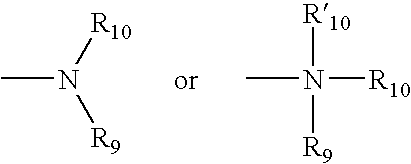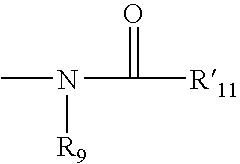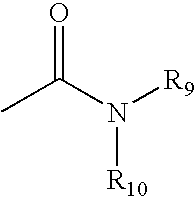Antipsychotic sulfonamide-heterocycles, and methods of use thereof
a technology of sulfonamide and heterocyclic compounds, applied in the field of antipsychotic sulfonamideheterocycles, can solve the problems of psychiatric disorders that are poorly treated and seriously underestimated, and compromise the quality of life of patients,
- Summary
- Abstract
- Description
- Claims
- Application Information
AI Technical Summary
Benefits of technology
Problems solved by technology
Method used
Image
Examples
example 1
Preparation of 3-Hydroxymethyl-piperidine-1-carboxylic acid tert-butyl ester
To a mixture of piperidin-3-yl-methanol (11.1 g, 96.37 mmol), K2CO3 (22.1 g, 160.0 mmol) in THF—H2O (50 mL-50 mL) at 0° C. was added (BOC)2O (23.2 ML, 101.18 mmol). The mixture was stirred overnight. The two layers were separated. Aqueous layer was extracted with EtOAc (2×50 mL). The combined organic solution was concentrated under vacuum. The residue was dissolved in EtOAc (100 mL), washed with sat. NaHCO3, brine, 5% HCl and brine, and dried over Na2SO4. After filtration, the filtrate was evaporated under vacuum to give 1 as a colorless liquid (20.57 g, 99%). 1H-NMR (300 MHz, CDCl3) δ 3.8 (broad, 2H), 3.41 (t, 2H) 3.00-2.70 (broad, 3H), 1.8-1.55 (broad, 3H), 1.4 (s, 9H), 1.2 (broad, 2H) ppm; 13C-NMR (75 MHz, CDCl3) δ 155.43, 79.71, 64.63, 46.46, 45.30, 38.38, 28.64, 27.59, 24.30 ppm; IR (neat) 3440 (broad), 2976, 2931, 2857, 16921426, 1366, 1267, 1176, 1076 cm−1.
example 2
Preparation of 3-Formyl-piperidine-1-carboxylic acid tert-butyl ester
To a mixture of oxalyl chloride (6.5 mL, 65 mmol) in CH2Cl2 (1.60 mL) at −55° C. was added a solution of DMSO (11 mL) in CH2Cl2 (30 mL) in about 20 min. After addition, the mixture was stirred about 5 min at −55° C. Then, a solution of alcohol 1 (13.77 g, 63.9 mmol) in CH2Cl2 (160 mL) was added dropwise in 30 min. After addition, the mixture was stirred for 30 min followed by the addition of Et3N (44.8 mL). The mixture was stirred for 20 min and then allowed to warm up to room temperature. H2O (160 mL) was added. The two layers were separated. Aqueous layer was extracted with CH2Cl2. The combined organic solution was dried with Na2SO4, filtered and evaporated to afford 2 as a light yellow liquid (100% yield). 1H-NMR (300 MHz, CDCl3)δ 9.7 (s, 1H), 3.95 (m, 1H), 3.70 (m, 1H), 3.30 (dd, 1H), 3.10 (m, 1H), 2.45 (m, 1H), 1.95 (m, 1H), 1.70 (m, 2H), 1.5 (s, 9H), 1.51 (m, 1H) ppm; 13C-NMR (75 MHz, CDCl3) δ 202.33, 154.51,...
example 3
Preparation of 3-Phenylaminomethyl-piperidine-1-carboxylic acid tert-butyl Eester
To a solution of aldehyde 2 (9.21 g, 43.23 mmol) in 5% HOAc in MeOH (100 mL) was added aniline (4.7 mL). The mixture was stirred at 0° C. for 10 min and NaCNBH3 (5.8 g, 92.3 mmol) was added slowly. The mixture was stirred at room temperature for 48 hrs. The reaction was quenched by addition of aq. NaHCO3 (50 mL), extracted with EtOAc (2×50 mL). The combined organic solutions were dried with Na2SO4, filtered and evaporated. The crude product was purified by silica gel chromatography (5-10% EtOAc in hexane as eluent) to give 3 as a light yellow liquid (10.0 g, 80% yield). 1H-NMR (300 MHz, CDCl3) δ 7.20 (t, 2H), 6.70 (m, 2H), 6.60 (d, 1H), 3.90 (m, 2H), 3.80 (m, 2H), 3.00 (m, 3H), 3.75 (m, 1H), 1.84 (m, 2H), 1.70 (m, 1H), 1.60 (s, 9 h), 0.9 (m, 1H) ppm; 13C-NMR (75 MHz, CDCl3) δ 155.13, 148.60, 129.46, 117.27, 112.92, 79.57, 53.82, 47.98, 46.91, 45.12, 35.67, 28.99, 28.71, 28.02, 24.56 ppm.
PUM
| Property | Measurement | Unit |
|---|---|---|
| covalent | aaaaa | aaaaa |
| stereoisomer | aaaaa | aaaaa |
| psychiatric disorder | aaaaa | aaaaa |
Abstract
Description
Claims
Application Information
 Login to View More
Login to View More - R&D
- Intellectual Property
- Life Sciences
- Materials
- Tech Scout
- Unparalleled Data Quality
- Higher Quality Content
- 60% Fewer Hallucinations
Browse by: Latest US Patents, China's latest patents, Technical Efficacy Thesaurus, Application Domain, Technology Topic, Popular Technical Reports.
© 2025 PatSnap. All rights reserved.Legal|Privacy policy|Modern Slavery Act Transparency Statement|Sitemap|About US| Contact US: help@patsnap.com



